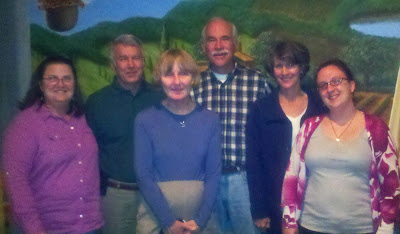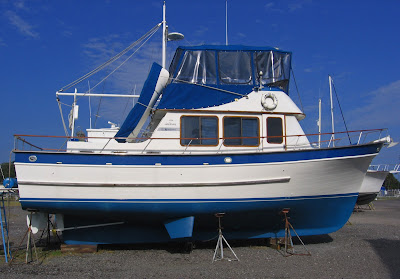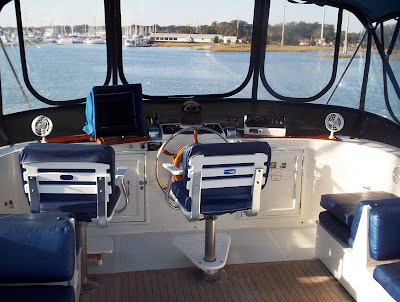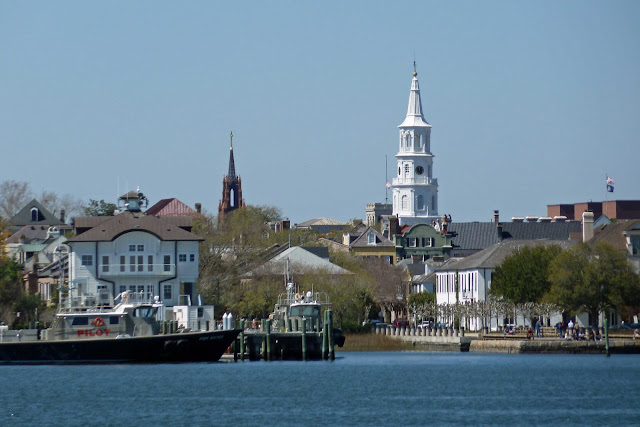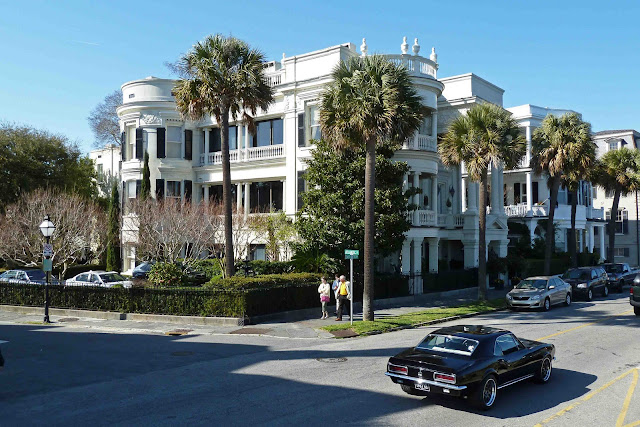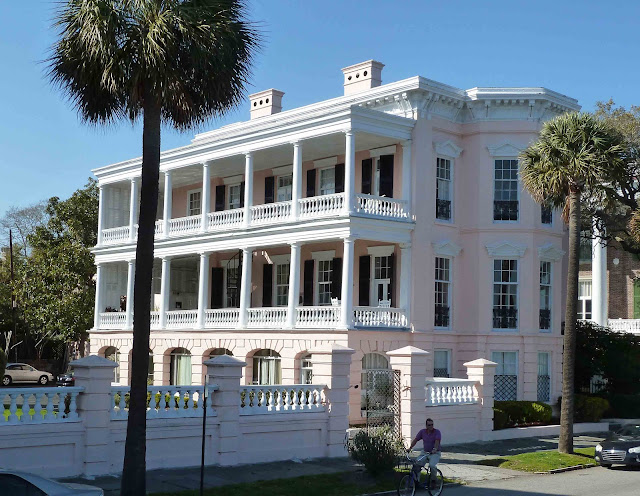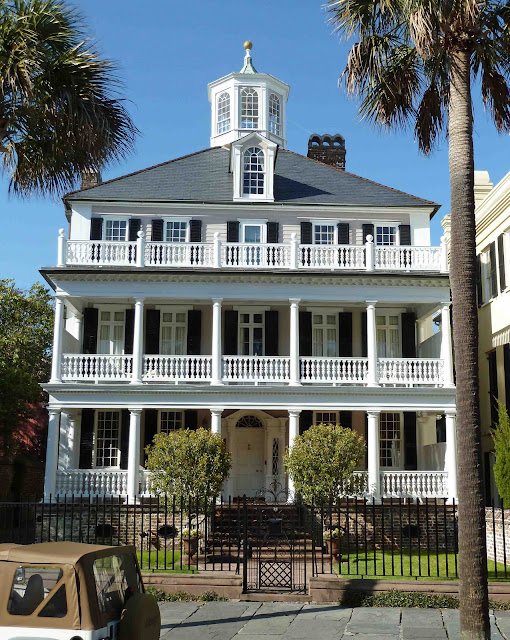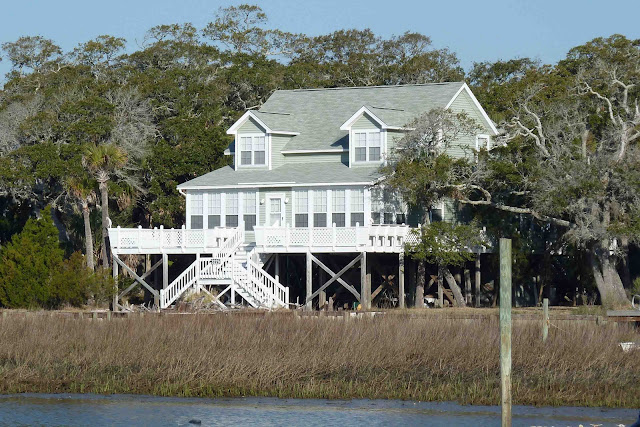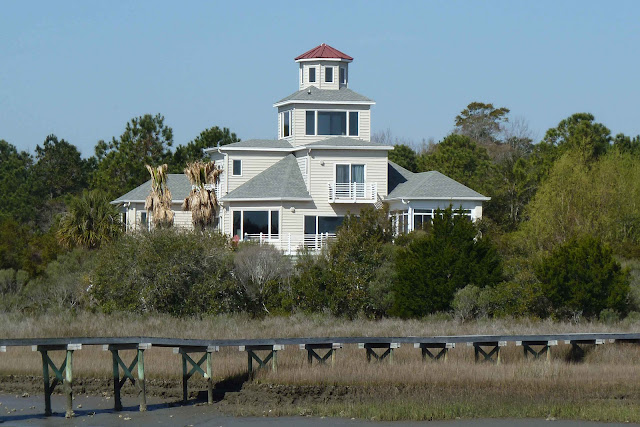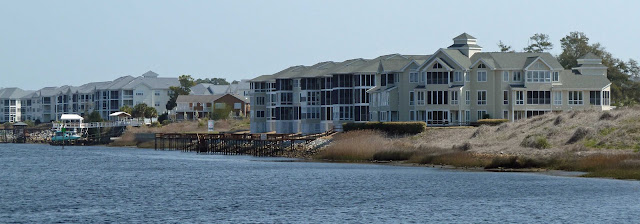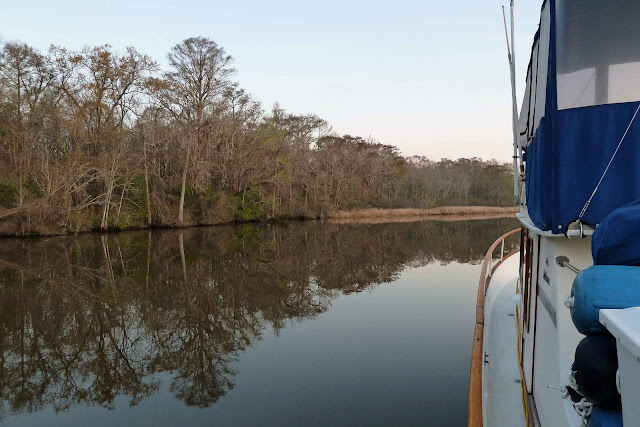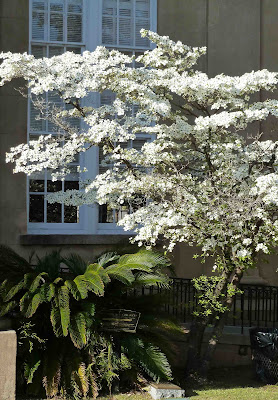The coastal geography of Georgia is similar to Florida in that there are a string of barrier islands along the Atlantic coast. That is the end of the similarities. The Georgia barrier islands are much farther from the mainland, from two to 20 miles. There are wide bodies of water, salt marshes, creeks, rivers, and additional islands between. The spaces between islands are large, sometimes multiple miles wide, creating sounds whose waters can be more like an ocean than an inlet. Some of the largest barrier islands are reachable only by boat. Many a cruising writer has stated that they hate traveling through Georgia because they find it boring – seemingly endless salt marshes and forested islands. We can only assume that they like the changing scenery of the Atlantic Intracoastal Waterway through Ft. Lauderdale where the waterway is lined with differing condos and large homes, all concrete and asphalt without a single a single growing thing. For us, we prefer the flora and fauna that the natural environment of Georgia provides.

Our first night in Georgia was spent at anchor in the north end of the Brickhill River on Cumberland Island. This is a favorite spot and we continue to enjoy the nature here. Our anchorage was just south of the dock on Hawkins Creek where Kim and Steve Hakala dock to visit their home on Cumberland. We are fortunate to have experienced guided tours of Cumberland by these two graduate biologists. You don’t realize how many stars are in the sky until you are at anchor in a place like Cumberland where the closest light pollution is miles away. Carl Sagan was right; there are billions and billions.



After a bit rocky passage through Jekyll and St. Simons Sounds, we anchored the second night on the Fort Frederica River near the ruins of Fort Frederica. The British built a fort and town on St. Simons and successfully defended it against the Spanish. But, the settlement only lasted 15 years. A small portion of the fort and the foundation of some of the homes is all that remains. It is a park that is both beautiful and educational.


Sapelo Sound had the current running out with the wind coming out of the east. When the wind opposes the current, it causes the water to wrinkle. The stronger the current and the stronger the wind, the bigger the wrinkles. These wrinkles are normally called “sea state” or waves. The waves were over 4 feet and were right on the nose. The spray coming over the bow reminded us of those old WWII movies with big battleships plunging into the waves and spray carrying over the top of the ship. One of the reasons we have a DeFever designed boat is that seas such as these are easy for the boat to handle. The limiting factor on large waves is determined by the crews’ stomachs, not the capability of the boat. The evening was another quiet one, spent at anchor on Walburg Creek next to St. Catherines Island, with the island providing shelter from the wind. By morning the waters were calm.


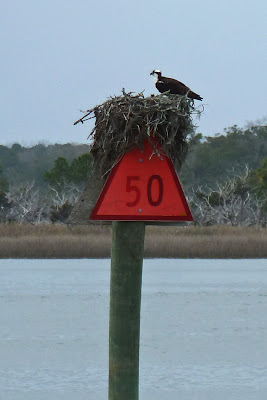
Critters are always interesting, but dolphins seem to create a special experience that is indescribable. People are drawn to dolphins. There seems to be a communication. Whenever a dolphin heads toward the boat we have to see if it is going to take a ride in the bow wake. Some dolphins have ridden alongside the boat for miles. Jill has a high-pitched voice she uses to talk to the dolphins and they seem to respond by rolling on their side and looking up at her. In the photo on the left, Jill is communicating with a dolphin, and if you look closely, you can see another one, in the upper right-hand corner of the image, heading toward the boat. It joins the first and Jill signals that 2 dolphins are in the wake.
Ospreys prefer to build their nests in the top of dead trees, and a navigational day marker must look much like a dead tree to them. They become used to boats passing by and later in the Spring little one's heads will be visible.
All through Georgia we were accompanied by seagulls, particularly Laughing Gulls. As we approached St. Andrews Sound with a 25 knot headwind, the gulls were able to draft the boat and just soar behind us. NASCAR drivers were not the first to learn about drafting. Sometimes there were so many birds following us that it appeared to be a scene from a Hitchcock movie.
Between Brunswick and Savannah, there are a number of houses built on spoil islands. These islands were created when the Intracoastal was dredged and the dredgings (spoil) were pumped into a spot in the marsh. We have never seen any sign of privately owned spoil islands in Florida, but this section of Georgia had quite a few. Most have little fishing shacks with a dock, appearing to be rustic weekend hide-a-ways. But, a couple were grand homes on very small and very low pieces of dry land. Big house/small island.

Next stop was near Savannah, where we spent a few days on Taylor Creek at a new friend’s dock behind his house. Steve Westgate is also planning to cruise the Great Loop this year and offered the use of his private dock for Last Dance. It was a very secure place to leave the boat as we had to make a trip to Clearwater for a doctor’s appointment. Last Dance is pictured at the Westgate dock below. The first thing a boater looks for when coming back to his/her boat is to see if it is still floating. Now, look at the second picture. Could be a bit scary if we didn’t know that the tides in this area are over 7 feet.
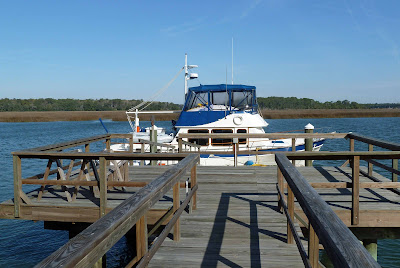

We also met Bruce and Jeanne Elder, who completed the Great Loop in 2007, spending two years on the trip. They said it was foolish to do it so quickly by only spending one year on the trip. To provide an opportunity for conversation, they drove us to the Sundae Café on Tybee Island, a restaurant located in an old, small strip mall between a BP gas station/convenience store and a liquor store. We had one of the best meals in our experience. Outstanding seems much too tame a word to describe the food. Jill had another great version of shrimp and grits to add to her collection. Put the Sundae Café on your list and next time you visit Savannah, take a drive out to Tybee Island to experience this culinary delight. Reservations necessary. Our final evening in Savannah, Steve and Beth took us to an interesting Greek restaurant. Forgot the camera and the lens on the phone camera must have been badly smudged, but below are Beth, Steve, Barbara Dein (previous owner of Last Dance who was visiting Savannah) your blog hosts and Rebecca Westgate, Steve and Beth’s daughter. One of the great things about traveling by water is the great people you get to meet -- a journey is not measured by the miles you make; it is measured by the friends you make along the way.
